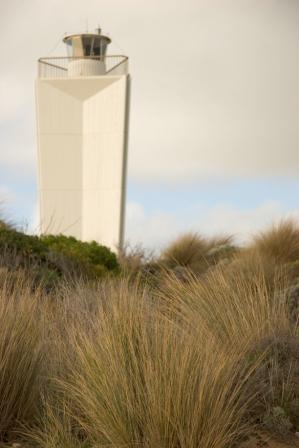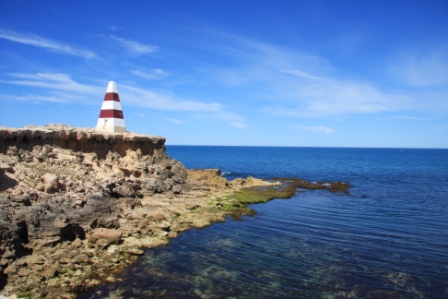Robe Lighthouse
The Robe Lighthouse was built in 1972 on the western edge of the township to replace the historic Cape Jaffa Lighthouse, which was relocated from the Margaret Brock Reef and set up as a museum at Kingston, after 100 years of manual operation.
A star-shaped concrete tower, the Robe Lighthouse is 3.5 metres wide at the bottom and slants towards five metres wide at the top. The light array is three vertical banks. Each bank is made up of five 200-watt, headlight-type lamps. The optics consists of a revolving hexagonal column of sealed beam lamps, showing a character of three flashes every 10 seconds with an intensity of 410,000 candelas, visible up to 37 kilometres out to sea. The tower is 18 metres high and 63.1 metres above sea level.
Situated in an easily accessible location on the western edge of the township, the lighthouse has always been automatic, and therefore unmanned. The low-lying building adjacent to the tower houses a standby power plant, which starts automatically when mains power fails.
The lighthouse was not the first built at Robe. A small wooden building containing a kerosene lamp once sat on the rocky outcrop at the eastern end of Town Beach. Designed to guide ships away from hazards east of Cape Dombey, it began operating in 1895. For many years, it was tended by retired mariner Andrew Munro, who lit the lamp at sundown and then returned the next morning to put it out and refuel it.
Image: The original lighthouse overlooking Guichen Bay - c. 1923
Courtesy: State Library of SA

Image: Lighthouse as it stands today
The Robe Obelisk
The Obelisk was erected on Cape Dombey in 1855 as a 'day guide' for ships entering Guichen Bay. The aim was to create a landmark that could be seen up to about 16 kilometres out to sea in ordinary weather.
A pyramid-like structure standing 12.2 metres tall, it was constructed by local builder George Shivas at a cost of £230. Bullock teams delivered the stone to the challenging site, crossing rocky ground. The final cap, made out of one heavy piece of stone, was swung into place using a frame, built over the apex.
The obelisk was originally a single colour, but it proved difficult to sight against the pale backdrop of Guichen Bay's sandhills, so in 1862 the government decided to have it painted with three white stripes and two red, each about 2.4 metres high, creating Robe's most famous landmark.
The obelisk was also used to store rocket equipment for the local lifeboat crew.
Since it was built, the soft sandstone cliffs on which the obelisk stands have eroded significantly, meaning it will eventually fall into the sea.

